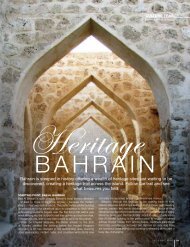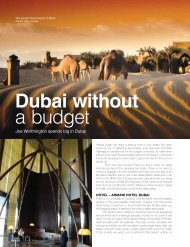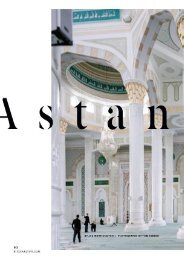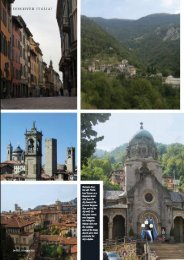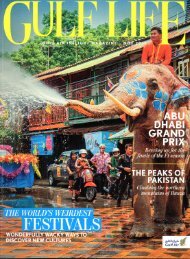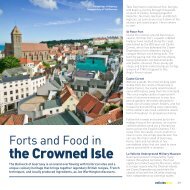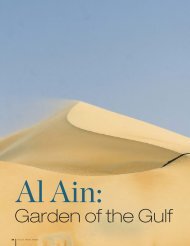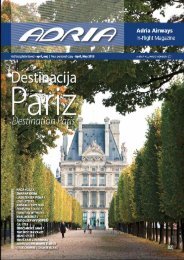You also want an ePaper? Increase the reach of your titles
YUMPU automatically turns print PDFs into web optimized ePapers that Google loves.
<strong>Souk</strong><br />
style<br />
What to buy in the<br />
world’s best <strong>Souk</strong>s<br />
The Middle East is famous for its mystical<br />
souks, where tantalising smells lure<br />
visitors deeper into the mesmerising<br />
lanes and alleyways of these historic<br />
marketplaces, where a confusing concoction of<br />
bright golds, oranges, greens, and blues flash<br />
by like a mirage, and boisterous sounds of<br />
people haggling thunder through the narrow<br />
streets of these centres of commerce.<br />
Join Joe Worthington on a journey through<br />
the most exciting souks in the Middle East and<br />
North Africa and follow in the footsteps of<br />
millions of bargain hunters through centuries<br />
gone by. As we delve into these havens of<br />
spices, traditional clothing, jewellery and<br />
antiques we will discover both famous and not<br />
so famous treasures to hunt for whilst getting<br />
lost in these confusing mazes. Sometimes it’s<br />
good to let go of your inhibitions and just follow<br />
everyone else. What’s the worst that could<br />
happen? We could find something new that<br />
would look great as a centrepiece on our dining<br />
room table. Or we could find a new recipe to<br />
take home a show-off to friends and family.<br />
Grand Bazaar, Istanbul<br />
54<br />
FOOD & TRAVEL ARABIA
MUSCAT, OMAN – MUTTRAH SOUK<br />
Muscat’s Muttrah <strong>Souk</strong> may not be as famous as some of the other markets in the<br />
region, partly because of its location away from the glitz and glamour of Dubai or the<br />
proximity to Europe or Morocco, but it is no less impressive than its more famous<br />
neighbours. Staying low-key has allowed Muscat’s souk to keep its centuries old<br />
heritage and unique culture; and most importantly, traditional gifts and wares have<br />
not been taken over by cheap Asian imports. The Muttrah <strong>Souk</strong> has an authenticity<br />
that just has to be discovered.<br />
When you first arrive at the grand entrance to the souk, complete with its Islamic-style<br />
domed staircase, you would be forgiven for thinking that the souk is tiny because you<br />
can see from one end to the other through the roofed walkway. However, there are<br />
tens, if not hundreds, of small disconcerting alleyways overflowing with an intoxicating<br />
array of small stalls, cafes and obscure meeting areas. Local Omani men can be seen<br />
doing their weekly shop in the market, dressed in clean white dishdasha and neatly<br />
wrapped colourful masar on their heads.<br />
There are thousands of hidden treasures waiting to be discovered deep inside<br />
Muttrah, the most impressive of which has to be an Omani khanjar, a Bedouin<br />
ceremonial dagger in a hook shape. Before the beloved Sultan Qaboos came to<br />
power only royals were permitted to wear these, but now Omani men can often be<br />
seen with them hanging from their waists. There are stalls hidden in the souk selling<br />
these daggers, some made from golds and silvers, and some from coppers and<br />
brass. There are even shopkeepers who can design the khanjar especially for the<br />
wearer and have them delivered within a few weeks. Look out for these expertly<br />
shaped daggers with their intricately carved designs on the sheath and try to haggle<br />
for the best price.<br />
Oman is also famous for its frankincense, an aromatic resin or oil that can be<br />
added to perfumes and bath products. These nuggets of yellow or green resin are<br />
famed across Oman for their medicinal properties, including as an indigestion aid,<br />
a flu reliever, and a scar or acne remedy. You might not be familiar with this truly<br />
Middle Eastern miracle cure, but the stall owners are. Just follow your nose; follow<br />
the unfamiliar scent and you will find.<br />
FOOD & TRAVEL ARABIA 55
MARRAKESH, MOROCCO – DJEMAA EL-FNA<br />
Djemaa El-Fna, North Africa’s synonymous souk is also possibly the<br />
world’s most famous marketplace. This hot, smelly and crowded<br />
souk in the middle of Marrakesh is a common feature in every<br />
brochure advertising Morocco, along with its packed rows of bright<br />
spices in baskets, steaming pots of Moroccan mint tea, and red fez<br />
hats hanging from shop walls. There is nowhere else on earth quite<br />
like Djemma El-Fna, Morocco’s well-known gem.<br />
Set in the old medina of Marrakesh, this symbol of Berber<br />
traditions is a cacophony of storytellers, musicians and performers<br />
competing to attract the attention of visitors. The place really comes<br />
alive at night; this is when the food stalls selling everything from<br />
camel stew to steamed snails come alive, and when traditional<br />
snake charmers and monkey handlers come out. The smells of<br />
cooking food and shisha smoke combine to create a confusing<br />
haze as the sun sets over the towering minaret of the Koutoubia<br />
Mosque.<br />
When you set off to explore this confusing system of tall walled<br />
lanes and streets you simply cannot avoid basket after basket full of<br />
brightly coloured spices and herbs. Sourcing the most fragrant and<br />
best tasting spice is to be recommended on a visit to Djemma El-<br />
Fna. Haggle for cinnamon, cloves, mint and chilli with the seemingly<br />
endless array of stallholders with a wide variety to choose from.<br />
Baskets filled with dates and mint leaves are also to be found in<br />
abundance, and here’s why.<br />
ISTANBUL, TURKEY – GRAND BAZAAR<br />
Istanbul’s huge Grand Bazaar is one of the world’s oldest indoor<br />
markets, first opened in 1461, and it sells everything that you could<br />
ever want, ranging from knock-off designer clothing, traditional Turkish<br />
memorabilia, Ottoman antiques, and the latest technology. Travel<br />
writers and explorers have been writing about the bazaar for centuries,<br />
including in the 17th century when Europeans detailed the town-like<br />
design of the market. There were reportedly 67 roads, 7 fountains, 5<br />
mosques, and 18 entry gates inside the bazaar, many of which still<br />
exist in some form to this day – although an earthquake in 1894<br />
destroyed much of the structure.<br />
There are roads of market stalls lining the impressively carved building,<br />
each road with a specific concentration of goods. There are roads of<br />
jewellers and gold on Kalpakcılar Caddesi, furniture along Divrikli<br />
Caddesi, carpets on Sahaflar Caddesi, leather goods along Perdahçılar<br />
Caddesi, and modern designer clothes on Bit Pazarı. The Grand Bazaar<br />
is a great place to try your hand at haggling because the sellers overprice<br />
their wares, often by more than double the cost price.<br />
One of the most popular souvenirs that visitors to the Grand Bazaar<br />
search for is a traditional Turkish Eye called a Nazar, a mythical blue<br />
eye coloured pendant that comes in the form as a necklace, bracelet,<br />
keyring, or photo. Tradition dictates that the amulet protects the owner<br />
from the “evil eye”, an ancient legend in which an evil glare from an<br />
enemy causes misfortune and injury. Whether or not you believe the<br />
legend, the eye makes for a great souvenir to take home as a<br />
memento of your visit to Istanbul and its Grand Bazaar.<br />
56<br />
FOOD & TRAVEL ARABIA
CAIRO, EGYPT – KHAN EL-KHALILI<br />
Cairo’s ancient souk is quite possibly the world’s oldest marketplace<br />
still in existence, surviving invasions from Persians, bombardments<br />
from Ottomans, riots and coups over its 11 century lifespan. The souk<br />
is at the heart of the Islamic district of the city, between al-Mu’izz Street<br />
and the Al-Azhar Mosque, and has been the focus of both the<br />
commercial and social lives of Egyptians for almost as long as the city<br />
has existed.<br />
At night the market takes on a new life. Dimly lit alleyways shrouded<br />
in shadows in the flickering candlelight and caverns full of souvenirs<br />
and antiques create an eerie atmosphere amongst the 16th century<br />
carved stone gates and dome-like walls. Every corner of the souk has<br />
been taken by sellers, some catering for tourists and others locals.<br />
Nothing symbolises the Arab world more than the hectic haggling and<br />
echoes of Arabic bouncing between the walls that at Khan el-Khalili.<br />
Fabric production has been the mainstay of the Egyptian economy<br />
for millennia, so what better souvenir to buy than a hand produced<br />
shawl or Egyptian cotton bed cover. Egyptian cotton is world<br />
renowned for its smooth feel and high quality, and it comes in almost<br />
every colour imaginable. Look out for hundreds of towels hanging<br />
from racks in hidden stalls and try to haggle for your favourite. It’s also<br />
worth searching for papyrus artefacts, they may not be authentically<br />
ancient Egyptian, but they make good gifts nonetheless.<br />
You can’t visit Egypt’s oldest souk without hunting for some<br />
ancient Egyptian artefacts, be they thousands of years old or just a<br />
few weeks old. There are lots of tourist oriented stalls selling all<br />
manner of sphinx and sarcophagus statues, but the most eagle<br />
eyed shoppers could spot some genuine local antiques. Expect to<br />
pay a high price for anything genuine though as the sellers are well<br />
aware of what they are selling.<br />
Shopping in souks is an eye opening experience that gives<br />
visitors a true insight into the life of locals in a city. <strong>Souk</strong>s are<br />
traditionally where locals come to gossip, meet friends, and do<br />
their weekly shop. They are also a haven of hidden treasures just<br />
waiting to be discovered, just don’t forget to take some smaller<br />
value notes with you when you go out to explore these mystifying<br />
mazes of commerce.<br />
Clockwise from above: Djemaa El-Fna; Grand bazaar interior; Khan el-Khalili exterior; Khan el-Khalili lamp shop; Khan el-Khalili vegetable; Grand<br />
bazaar pottery; Djemaa El-Fna Marakesh snake charmer; Djemaa El-Fna spices<br />
FOOD & TRAVEL ARABIA 57





